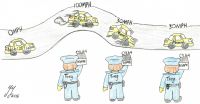INFORMATION:
The Huck Institutes of Life Sciences, National Institutes of Health, U.S. Department of Agriculture and American Association of Immunologists supported this work.
Sarkar and Kalia worked with Laura Anne Penny, laboratory assistant, and Yevgeniy Yuzefpolskiy and Florian Martin Baumann, both graduate students in molecular medicine.
Returning killer T cells back to barracks could improve vaccines
2015-06-16
(Press-News.org) Just as militaries need to have trained, experienced soldiers ready for future wars, making sure that the immune system has enough battle-ready T cells on hand is important for fast-acting, more effective vaccines, according to Penn State researchers.
In a study of immune response in mice, the researchers found that regulatory T cells -- Tregs -- are critical for the immune system's ability to remember and fight off future pathogen attacks. T cells, which are specialized types of white blood cells, play important roles in the immune system and immunological memory.
"Immunological memory is the capability of your immune system to remember the diseases and pathogens it fought off in the past, and the generation of long-lived immunological memory is the basis of effective vaccination," said Surojit Sarkar, assistant professor of immunology in veterinary and biomedical sciences.
Sarkar likens the immune system, which is made up of many different cells, to an army that battles pathogens and diseases that are invading the body. Initially T cells are called up to attack the pathogens, but these cells, called naïve T cells, have no experience or immediate defenses against the invader. As the T cells increase in number and generate defenses to take on the threat, they become effector -- or killer -- T cells.
Once the battle is over, though, the immune system retains some killer T cells that have encountered the pathogen as memory T cells, Sarkar said.
"Once the T cells clear the pathogen, just like in warfare, you do not leave your weapons drawn, you holster them," said Sarkar. "In the case of the immune system, those charged killer T cells also downregulate their killer machinery."
The researchers found that the regulatory T cells, another type of T cell commonly known for their role in preventing the immune system from attacking the body's own cells and tissues -- autoimmunity -- suppressed the killer T cells through a protein on their surface -- cytotoxic T-lymphocyte associated protein-4.
"I like to think of Tregs as the police of our immune system -- their job is to keep other immune cells in check, said Vandana Kalia, assistant professor of immunology in veterinary and biomedical sciences, who worked with Sarkar on the study. "In the case of memory T cells, Tregs serve to keep their killer functions in check and help maintain them in a quiescent, yet ready to kill, state."
She added that the CTLA-4, expressed at high levels on Tregs, applies the brakes on these activated killer T cells to slow them down.
According to the researchers, who report their findings in today's (June 16) issue of Immunity, the study could have a far-reaching impact on immunity to a wide array of infectious diseases and even cancer vaccines and tumor immunity.
The researchers suggest that accelerating T cell memory following an immunization could lead to vaccines that become effective more quickly. For example, health care workers who are preparing to go to the field to fight an epidemic might only need to wait days, rather than weeks, for their vaccinations to become effective.
The findings could also help guide the development of future vaccines.
"What our study is doing is looking at the basic concepts of how the immune system's memory develops and such fundamental information is critical for advancing our current vaccine development efforts," said Kalia.
Although the last few decades have established the importance of immunological memory in vaccination, the basic idea has been known for centuries, said Sarkar.
"The Greek historian Thucydides observed that people who had been exposed to the plague once -- and survived it -- felt more comfortable helping other plague victims because they knew that they would not be attacked fatally again," said Sarkar.
ELSE PRESS RELEASES FROM THIS DATE:
Significance article offers roadmap to fight reproducibility crisis
2015-06-16
ALEXANDRIA VA, JUNE 16, 2015 - Dramatic increases in data science education coupled with robust evidence-based data analysis practices could stop the scientific research reproducibility and replication crisis before the issue permanently damages science's credibility, asserts Roger D. Peng in an article in the newly released issue of Significance magazine.
"Much the same way that epidemiologist John Snow helped end a London cholera epidemic by convincing officials to remove the handle of an infected water pump, we have an opportunity to attack the crisis of scientific ...
Researchers identify new stem cell population important in the growth of colon cancer
2015-06-16
London, Ontario, June 11 -- Researchers at Lawson Health Research Institute have identified a new stem cell population in the colon linked to cancer growth. The findings, which were recently published in the prominent journal Cell Stem Cell, will significantly change the way we study and treat colon cancer.
Colon cancer is the second leading cause of cancer death in Canada. It is estimated that in 2015 that 25,100 Canadians will be diagnosed with colon cancer representing 13 percent of all new cancer cases.
Dr. Samuel Asfaha, a clinician-scientist at Lawson and an ...
Toxic algal blooms behind Klamath River dams create health risks far downstream
2015-06-16
CORVALLIS, Ore. - A new study has found that toxic algal blooms in reservoirs on the Klamath River can travel more than 180 miles downriver in a few days, survive passage through hydroelectric turbines and create unsafe water conditions on lower parts of the river in northern California.
Water-borne algal blooms can accumulate to concentrations that can pose health risks to people, pets and wildlife, and improved monitoring and public health outreach is needed to address this issue, researchers said.
The frequency, duration and magnitude of harmful algal blooms appear ...
Can personal devices interfere with hospital care?
2015-06-16
This news release is available in French. Montreal, June 16, 2015 -- Thousands of patients die each year in hospitals across North America due to medical errors that could be prevented were doctors and nurses provided with instant access to patient records via wireless technology. Cue the catch-22: the electromagnetic radiation caused by those very devices can interfere with electronic medical equipment and thus lead to serious clinical consequences for patients.
Luckily, that could soon change thanks to new research from Concordia University that helps define a ...
Tracking the viral parasites cruising our waterways
2015-06-16
Humans aren't the only ones who like to cruise along the waterways, so do viruses. For the first time, a map of fecal viruses traveling our global waterways has been created using modeling methods to aid in assessing water quality worldwide.
"Many countries are at risk of serious public health hazards due to lack of basic sanitation," said Joan Rose, Homer Nowlin Chair in water research at Michigan State University. "With this map, however, we can assess where viruses are being discharged from untreated sewage and address how disease is being spread. With that, we can ...
NASA sees Tropical Storm Bill making landfall in Texas
2015-06-16
Tropical Storm Bill was making landfall at 11 a.m. CDT on Matagorda Island, Texas on June 16 as NASA and NOAA satellites gathered data on the storm. At NASA a movie of Bill's landfall was created using data from NOAA's GOES-East satellite. The center of Bill is expected to move inland over south-central Texas during the afternoon and night of June 16.
On June 15 at 19:15 UTC (3:15 p.m. EDT) the MODIS instrument aboard NASA's Aqua satellite captured a visible image of Tropical Storm Bill approaching Texas and Louisiana. Powerful thunderstorms circled the center in fragmented ...
For those over 50, finding a job can get old
2015-06-16
Results from a new study led the Georgia Institute of Technology's School of Psychology and University of Minnesota's Carlson School of Management show that, compared to younger job seekers, older adults receive fewer job offers, search for weeks longer and are ultimately less likely to find re-employment after losing a job. The study is published by the journal Psychological Bulletin.
"There's very robust evidence that as an individual moves beyond age 50, they experience a large penalty toward how quickly they will find a job," says Professor Connie Wanberg, the Industrial ...
Clemson research: Vehicle direction, not driver biometrics, best way to detect drowsiness
2015-06-16
CLEMSON, S.C. - Drowsy drivers take a heavy toll on the nation's highways. So finding a reliable way to test for fatigue to mitigate its potential damage could have a significant impact on highway safety.
U.S. statistics reveal drowsy drivers are five times more likely to be involved in an accident, or a near-crash incident, than alert drivers. Furthermore, drowsy or fatigued drivers are responsible for an estimated 56,000 crashes annually with more than 40,000 of them resulting in fatal and non-fatal injuries. Closer to home, there are more than 730 traffic accidents ...
World spends more than $200 billion to make countries healthier
2015-06-16
SEATTLE -- The world invested more than $200 billion to improve health in lower-income countries over the past 15 years.
Global health financing increased significantly after 2000, when the United Nations established the Millennium Development Goals, which included a strong focus on health. This trend in funding has only recently started to change, according to new research by the Institute for Health Metrics and Evaluation (IHME) at the University of Washington. The article, "Sources and Focus of Health Development Assistance, 1990-2014," was published online June 16 ...
Renewable energy from evaporating water
2015-06-16
New York - An immensely powerful yet invisible force pulls water from the earth to the top of the tallest redwood and delivers snow to the tops of the Himalayas. Yet despite the power of evaporating water, its potential to propel self-sufficient devices or produce electricity has remained largely untapped -- until now.
In the June 16 online issue of Nature Communications, Columbia University scientists report the development of two novel devices that derive power directly from evaporation - a floating, piston-driven engine that generates electricity causing a light to ...



